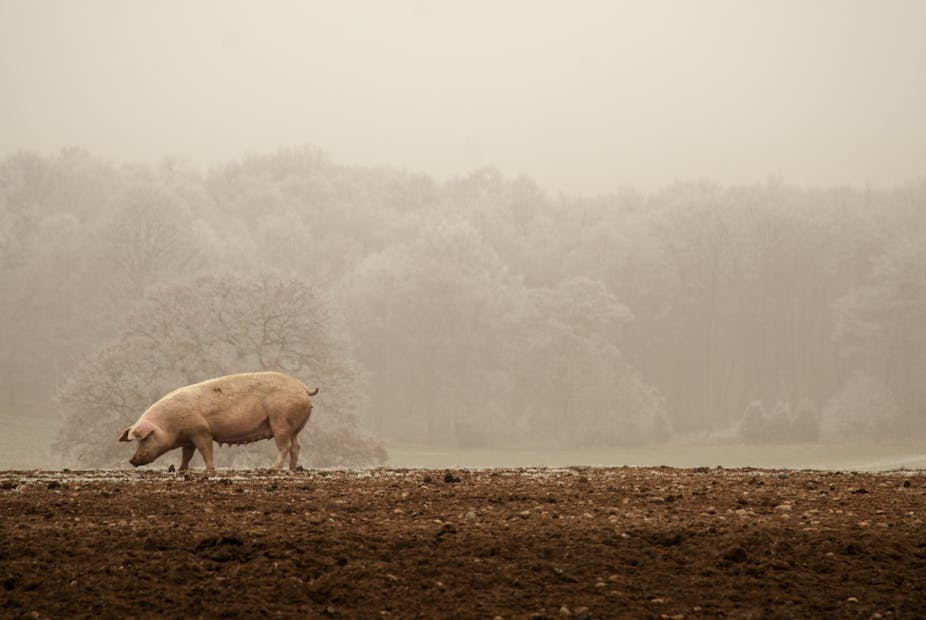Animals get a lot of the blame when it comes to human illnesses – chickens for salmonella, dogs for rabies, birds and pigs for avian and swine flu. Theses are all examples of “zoonotic diseases”, or diseases which can naturally be passed from animals to humans.
But this spread of infection is not a one way street. Humans are animals too, and we can pass diseases back to other species in a way that could seriously affect our efforts to contain harmful viruses.
Avian and swine flu are both Influenza A viruses (IAV), which may present one of our greatest zoonotic threats. They have the ability to cross species barriers and to form totally novel strains of the virus.
A perfect example of this threat was the 2009 swine flu pandemic, which spread across the world in a matter of months, killing somewhere between 151,700 and 575,400 people, 80% of whom were under 65. The virus responsible for the outbreak was H1N1. In particular, it was a strain of H1N1 which had been circulating undetected in the swine population for several years prior to its emergence in humans, causing only sub-clinical symptoms.
In general, the clinical symptoms shown by both pigs and humans as a result of IAV infection are very similar, including coughing, mucus production and lethargy. However, one of the biggest differences between flu in humans and pigs is the seasonality of the illness. Infection occurs all year round in pigs, unlike the winter outbreaks we see in humans.
The pandemic H1N1 virus was made up of genetic segments originating from avian, swine and human strains. In this case, the pig had acted as a mixing vessel for the virus to change its genetic form.
While it is now accepted that the 2009 swine flu pandemic was caused by H1N1 jumping from pigs to humans, what happened to the virus next is not often considered.
There have now been reports of the same virus being transmitted back into the swine population from humans, especially from swine workers on farms, meaning the virus could also be having a “reverse zoonotic” effect on pigs. This bidirectional transmission has so far been documented in the US, Canada, parts of Europe and has most likely occurred in the UK, too.

A US study reported at least 49 pandemic H1N1 transmission events from humans to pigs following the 2009 pandemic, but this was almost certainly an underestimation. Presumably, there would be more frequent human to pig transmission events during peak influenza season, but more research is needed to support this idea.
Saving their bacon
Human to pig flu transmission may also be aided by the structure of the pig industry. Young pigs brought onto a farm are unlikely to have been exposed to any IAVs circulating within the workers on that particular site, meaning they will have no immunity to novel strains. Meanwhile, farm workers are more likely to have built up at least some cross immunity to IAVs through exposure to different strains over time.
The movement of IAVs between species may increase the likelihood of further virus variation, especially if the pig has been infected with IAVs from multiple sources. In order to minimise the likelihood of IAVs adapting in pigs, perhaps we should consider making vaccination compulsory for anyone working with pigs. But this step would raise additional issues, such as which strains of the virus would be targeted by the vaccine, and the impact that vaccination may have on driving the evolution of IAVs.
It is also important to consider how this knowledge may impact study designs. For example, a recent trial carried out by my research group required staff to wear protective clothing, partly to protect us, but also to prevent the pigs becoming infected with IAVs other than the specified strain we were experimenting with.

But perhaps vaccination schemes are not the way forward and we should instead be focusing our attentions on improving surveillance strategies to try and identify emerging novel IAVs. The most effective control measures are likely to be a combination of both approaches.
And we need to look beyond pigs, too. If humans are transmitting IAVs to pigs, then there is a distinct possibility that other pathogens are also being passed back and forth between us and the domestic and wild species we live alongside. What other reverse zoonotic threats are out there? And who faces the greatest risks?

